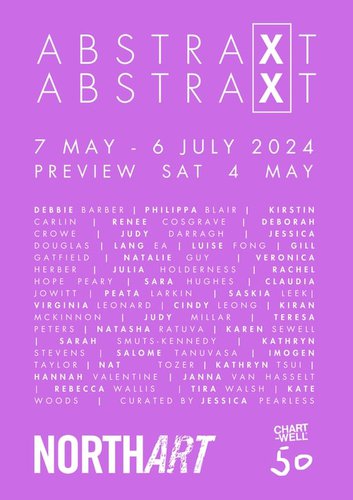John Hurrell – 27 June, 2024
Some artists (like Peata Larkin) have several items, others only one—but one with impact (for example, Rebecca Wallis). Overall though, those with more than one contribution have an advantage. You can get a broader sense of where their interests lie. For that reason the projects of Veronica Herber, Peata Larkin, Nat Tozer, Sara Hughes, Claudia Jowitt, Gil Gatfield, Natasha Ratuva, Hannah Valentine, Julia Holderness, Kirstin Carlin, Kathryn Tsui and Janna Van Hasselt have a convincing authority
North Auckland
Sculpture, video, installation and painting from 36 women
ABSTRAXT ABSTRAXT
Curated by Jessica Pearless
7 May - 6 July 2024
Outside of the burning issue of whether wilfully gender-specific exhibitions like this are dubious, out-of-date, or incisive (and clever at rustling up a back-up community), this group show of thirty-five women artists at Northart (see <https://www.northartgallery.net/-exhibitions> for some images) is incredibly diverse in the types of abstraction it presents—almost to the point of incoherence—with (in my view) too many participants and too many varieties. That’s if you assume it really has abstraction (or ‘abstraxtion‘ [something else]) as its hub, a pure dynamic core free of associations with the ‘real’ world, that theoretically energises nearly sixty contributions. Here it is mainly via painting, with a smattering of sculpture, installation, soundworks and video.
While the excessively wide range of image types and its enigmatic title make this an unpredictable exhibition to explore, that embraced multiplicity (ranging in potential content from formalism, spiritual symbolism, satire, appropriation, and more) seems to be the rationale behind its peculiar heading: for with the inserted saltire, the diagonal St. Andrew’s cross (apparent in the repeated noun/adjective) the heading creates a woozy, very slippery ambiguity.
Is the saltire to be understood as an abstract form, and so a witty affirmative sign in itself? Or is it instead mocking the now established art historical category it seems to be part of, being not an enthusiastic endorsement (where crosses actually serve as ticks), but in fact an attack on old ‘masculinist’ abstraction and an ushering in of something new? An underpinning feminist critique—a censure or erasure angry at past male domination—that wishes to celebrate abstraction as it is now, and not abandon it.
One other possibility is related to the above, that the X serves as an en-dash that functions as an absent letter, opening up dissected and separated parts of language to a wider range of words—and therefore new meanings.
Enough about its distinctive title. Curated by Jessica Pearless, one of the current directors of Northart and a participant via catalogue images only—the only one with a full double-page illustration—this rambling show is distributed throughout the two large rooms of the Northcote Centre gallery, the many non-figurative works (most are for sale) spread out into two separate sections. Although large works are included, the show overall favours small paintings that encourage close viewing and intimacy.
Some artists (like Peata Larkin) have several items, others only one—but one with impact (for example, Rebecca Wallis). Overall though, those with more than one contribution have an advantage. You can get a broader sense of where their interests lie.
For that reason the projects of Veronica Herber, Peata Larkin, Nat Tozer, Sara Hughes, Claudia Jowitt, Teresa Peters, Gil Gatfield, Karen Sewell, Natasha Ratuva, Julia Holderness, Kirstin Carlin, Kathryn Tsui, Hannah Valentine, and Janna Van Hasselt have a more convincing authority. There is more visual and conceptual substance to chew over in terms of each one’s individual focus and collegial differences.
In fact, fourteen artists alone, like those listed above, are more than enough to make a very satisfying exhibition, if say three carefully chosen works were allocated for each. There is no advantage in being unwieldy and too inclusive. Sprawling shows like this are soon forgotten. Concise and sparse (but very considered) selections on the other hand, get remembered.
John Hurrell

 Advertising in this column
Advertising in this column Two Rooms presents a program of residencies and projects
Two Rooms presents a program of residencies and projects



This Discussion has 0 comments.
Comment
Participate
Register to Participate.
Sign in
Sign in to an existing account.